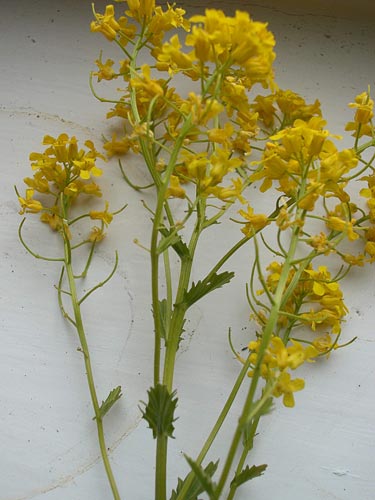Weeds
Barbarea vulgaris R.Br. - Garden Yellow rocket
Systematic position.
Family Brassicaceae Burnett (Cruciferae Juss.), genus Barbarea R.Br.Biological group.
Perennial weed with biannual shoots that form rootstocks.Morphology and biology.
Plant is 30 cm tall, with glabrous or slightly pubescent stems branching in their upper parts. Roots and lower stem leaves are petiolate, with 2-4 oblong lateral lobes and large, blunt, sinuate-serrated upper lobe with cordate base. Upper stem leaves are sessile, vary from lanceolate to obovoid, serrated along the edge. Inflorescence is raceme, not branched at the start of flowering. Flowers are golden yellow, consisting of four components; petals are twice as long as sepals. Fruit is silicle, oblong-linear, rounded-tetrahedral, with short clavate beak, bivalved, bilocular and multi-seeded. Silicle valves are stramineous, firm, glabrous, with prominent middle rib and hardly visible lateral ribs; their surface is slightly knobby. Peduncles are short, arcuate-deviated, directed slantwise upward. Silicle opens lengthwise upward, forming two slots and valves, which are separated from the middle longitudinal dividing wall. Seeds are ovate, compressed and gray-brown with faint luster; their surface is covered with small tubercles. This plant flowers in April-May, bears fruit in June-July, starting during second year of vegetation. After fruiting, the above-ground parts of the plant die off, and every spring a new flowering and fructiferous stem develops from root collar. B. vulgaris propagates by seeds and rootstocks. Maximum productivity is up to 10000 seeds. Minimum temperature for seed germination is 6-8°C, maximum is 38-40°C, and the optimum is 18-20°C. Seeds germinate quickly in summer, autumn and after over-wintering in spring from depths of no more than 4 cm, best of all from the depth of 0.5 cm. In the first year of its life cycle, the plant produces only a rosette of leaves with well-developed tap root, and, at this stage, it over-winters.Distribution.
European part of the Former Soviet Union, Ciscaucasia, Western Transcaucasia, Western Siberia, and Central Asia. It is also distributed throughout Western Europe and grows as an adventive plant in America, Africa and Australia.Ecology.
This plant develops in myriad soil types but prefers wet habitats. It can grow in semi-shady areas. B. vulgaris shatters in the beginning of summer before harvest of field crops, infesting soil with seeds.Economic significance.
B. vulgaris is mainly a weed plant of the forest zone, and, in the south it, occurs less often in over-moistened places. It infests perennial grasses, winter cereals, gardens, vegetable gardens, and, rarely, spring cereals and tilled crops. It grows in masses in poorly cultivated fallows with clay soils. As a ruderal plant, B. vulgaris grows in wet meadows, along rivers, in clearings, thickets, deforested places, near roads, along ditches, in sod fields and waste places. Its hay can be eaten by animals. This plant contains vitamin C. Young leaves have anti-scorbutic properties and are used as food. It is a bee plant. Seeds contain up to 35% fatty oil. Control measures include low mowing of weed during mass flowering of perennial grasses, shallow plowing, and pre-sowing harrowing and cultivation in autumn.Reference citations:
Agaev M.G., ed. 1988. Main agricultural weeds in crops of the Leningrad Region. In: Catalogue of VIR world collection. N 468. Leningrad: VIR. 112 p. (In Russian)Barbarea vulgaris. In: Plants For A Future-Species Database. 1997-2000. IBIBLIO. The public's library and digital archive: http://www.ibiblio.org/pfaf/cgi-bin/arr_html?Barbarea+vulgaris
Keller B.A., ed. 1934. Weed plants of the USSR. V. 3. Leningrad: AN SSSR. 448 p. (In Russian)
Komarov, V.L. & N.A. Bush, eds. 1939. Flora of the USSR. V. 8. Moscow-Leningrad: AN SSSR. 696 p. (In Russian)
Korsmo E. 1933. Weed plants of modern farming. Moscow-Leningrad: State Publishing House of Kolchoz & Sovchoz Literature. 416 p. (In Russian)
Nikitin, V.V. 1983. Weed plants of the USSR flora. Leningrad: Nauka. 454 p. (In Russian)
Ulyanova T.N. 1998. Weed plants in flora of Russia and other CIS countries. St. Petersburg: VIR. 343 p. (In Russian)
Zotova A.P. 1971. Weed plants and their control. Leningrad: Lenizdat. 144 p. (In Russian)


